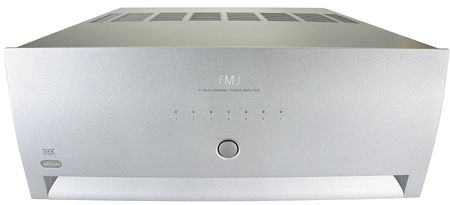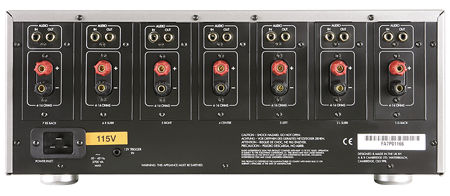Arcam FMJ AV8 7.1-channel preamplifier-processor & FMJ P7 7-channel power amplifier Page 2
The AV8 was unusually quiet (not that I heard noise per se coming from any of the receivers I've reviewed), which let me hear farther into the soundstage. The result was high-end resolution of ultra-low-level detail and 3-dimensional soundstaging from 2-channel material. And cranking up the volume in no way diminished the AV8's superb sound. In fact, doing so highlighted both the unit's thundering macrodynamic capabilities and its facility for delineating the small, microdynamic shifts in between that allow music to breathe naturally. That ability, more than any other, spells the difference between passive and active listening—or between mechanical and believable sound reproduction—and is one of the reasons vinyl fanatics prefer analog to digital—especially low-resolution digital. I hadn't heard this level of musical performance in my home theater since I'd reviewed the expensive all-Linn AV51 system mentioned above (and named Product of the Year in our January 2000 issue).
Speaking of analog, the AV8's optional MM/MC phono module proved to be more than the mere afterthought it tends to be in most receivers. I used Music Hall's MMF-9 turntable, which includes the moderately high-output Goldring Maestro moving-coil cartridge, and found the AV8 phono section's analog performance in Direct mode commensurate with its digital performance—especially in terms of bass solidity, transparency, pacing, and rhythm. Lesser phono sections can sound mechanical, soggy, or dynamically compressed. I'm not suggesting that Arcam's can compete with multi-thousand-dollar standalone units, but it will be a useful option for vinyl listeners.
Beyond its superb dynamic presentation, the AV8's performance at the frequency extremes was noteworthy. Bass extension and, especially, control and rhythmic dexterity, were of audiophile quality, as demonstrated by Brian Bromberg's Jaco (A440 Music Group A440-4022). When I went back to my long-term reference receiver, the Integra DTR9.1, using it as a preamp with Arcam's FMJ P7 7-channel power amp, the sound of Bromberg's bass softened, and seemed to slow down and lose its rhythmic authority. While it wasn't fair to compare a $3000 receiver used as a preamp to a $5000 dedicated preamp-processor, the comparison sure let me hear what that price difference will buy: an enormous improvement in sound.
As for the AV8's Dolby Digital and DTS performance in all modes—that is, the channel separation and spatial characteristics needed to create a well-resolved multichannel soundfield on film soundtracks—I can't say it was better than that of the best receivers I've auditioned. If it was, it couldn't have been to any significant degree. When I'm watching a movie, I don't think my brain locks on to such information unless something is really wrong, and the high-quality decoding performance of most modern receivers is such that there's not much more to be retrieved in this respect than what they can provide.
To check the transparency of the Arcam's video circuits, I compared the terrestrial high-definition feed of a football game sourced through my RCA DTC-100 digital tuner through the AV8 and 30 feet of AudioQuest component-video cable (needed to route the signal through the walls to the TV) with the ATSC tuner built into my Hitachi 65XWX20B CRT RPTV. Apart from the intrinsically somewhat different pictures produced by these two tuners (I've compared them with the DTC-100 run directly into the set), the AV8's video switching was essentially transparent. Yes, there was, perhaps, an ever-so-slight softening of edge detail on the source passing through the AV8. But that could have been due to differences other than the Arcam's video switching circuitry.
As for problems and glitches, there were two: When I switched between digital sources, occasionally there was a slight burst of white noise, but it wasn't loud; also, the AV8 occasionally wouldn't lock to the DTC-100's Dolby Digital output. The only way to restore it was to turn the AV8 off, then back on.
Otherwise, the AV8 behaved flawlessly. It was such a pleasure to have in my system that I didn't want to send it back!
FMJ P7 7-channel Power Amplifier
A high-powered multichannel power amplifier is an unusual product for a British company, but Arcam has evidently decided that they needed to crack the American home theater market. They chose to enter with a 150Wx7 (into 8ohms; 230Wx7 into 4ohms), modular design. Each amp module—one per channel—includes rectification and 20,000F of storage capacitance, all fed by two 1500VA toroidal power transformers. According to Arcam, this ensures that each module can deliver full output at all times.

Do you really need 160W for your EX/ES effects channels? An alternate setup would make use of the P7's easy-to-implement biamping facilities: you could biamp the L/R mains, use the three remaining channels for the center and main surrounds, and add a smaller 2-channel amp for the ES/EX channels, if you're even bothering with them. [Or, even better if your budget allows, use six of the seven channels to biamp all three front speakers, use the seventh amp channel for a single center surround, and add that additional 2-channel amp for the main surrounds.–TJN]
A microprocessor-controlled sequential turn-on system powers up one module at a time to avoid drawing too much current. This system also allows remote turn-on from a 12V trigger input. And despite the huge current draw and heat generated by the modules, under most circumstances an ingenious convection cooling system should prove sufficient airflow to keep them within normal operating temperatures. A variable-speed cooling fan is built-in just in case, but I never heard it.
I used the FMJ P7 to drive a variety of speaker systems, including the Audio Physic Virgo III reviewed in last month's SGHT, and a big, beefy Aerial Acoustics system consisting of two LR5s, two L3s used as surrounds, and the new CC5 center-channel. I even used it to drive the tiny Alón Napoleon assemblage: clearly a case of power overkill! (Reviews of the Alón and Aerial systems are in progress.)

Overall, the P7 was a rich, thoroughly nonmechanical-sounding assemblage of amplifiers that should have plenty of power for most home-theater applications—its rated output is continuous power with all channels driven, and power increases as impedance drops. The P7's sound was on the warm, rich side of neutrality. It sacrificed a bit of detail and air in favor of midrange coherence—not necessarily a bad thing, considering how many soundtracks sound bright and over-processed.
Yet when I did last month's DVD-A/SACD roundup, I found the amplifier's richness in no way detracted from its musical reproduction. It offered a taut, extended bass foundation, cleanly rendered transients, and midrange richness, all in a pleasing overall balance. This character was a perfect match for the neutral, well-balanced Virgo III system, and the P7 had enough power to drive the Virgos to what I considered their full dynamic expression.
However, despite the P7's 230Wpc rating into 4ohms and the 4ohms rating of the power-hungry Aerial speakers, I felt the P7 wasn't up to the task of getting the most from the Aerials in terms of dynamic contrasts and sock. So I brought my 2-channel reference amp, the Musical Fidelity Nu-Vista 300, upstairs and drove the front L/R pair of Aerial L5s with it. With more than 600Wpc available into 4ohms, the Nu-Vista yielded a punchier, more spacious picture. Later, I was lucky enough to be able to borrow three Theta Citadel monoblocks for the front array; only then were the Aerial system's resolution, dynamic expression, and overall punch truly revealed. In fact, inserting the Citadels into the system made me realize that the AV8 preamp was even better than I'd thought it was.
The P7 may give up some muscle on the bottom and some air and resolve on top compared to far more expensive separates, but it's a wonderfully "musical" amplifier that offers midband richness and overall coherence that will be especially attractive to those using a home-theater system for music reproduction. More important, it doesn't overlay the music with hardness, etchiness, or mechanical qualities. Its presentation was well-balanced, dynamically assured, and rhythmically lithe for music, and sufficiently powerful and gripping to communicate the essence of the most complex, dynamically challenging film soundtracks.
Wrapping it Up
The Arcam FMJ AV8 and FMJ P7 proved to be one of the most enjoyable A/V assemblages I've had in my home theater. The FMJ AV8 in particular was an ear-opener for someone who, like me, comes from the receiver side of the tracks. It demonstrated that great sound need not be sacrificed to accommodate video circuitry, and its $5000 price struck me as a bargain, given what good 2-channel preamps can cost. The P7 was yet more proof that great sound can come in a multichannel package. In all but the most demanding of circumstances, it should be the AV8's perfect companion.
Together, for less than $10,000, these impressive products will give audio/video-philes a sonic ride to savor for many years to come. It wouldn't be overstating the case to say they sound like a million bucks.




























































